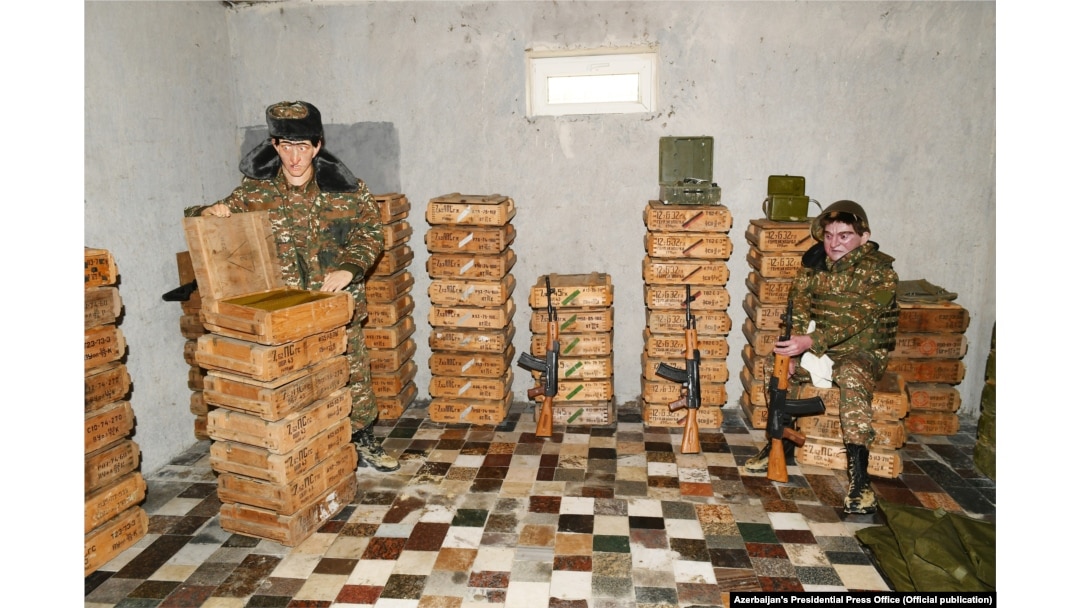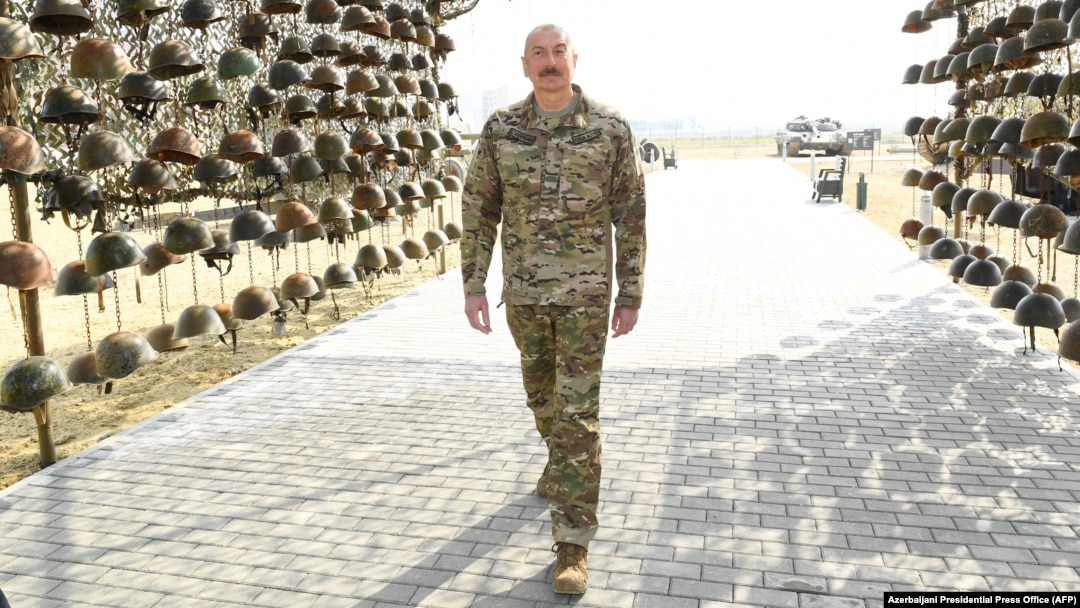Many countries have war museums, paying tribute to a conflict's combatants and chronicling the battles that usually resulted in a great victory for the nation.
What's less usual is for such a museum to open mere months after the war and to feature cartoonish-like mannequins of the enemy soldiers.
Yet that is what is on display in downtown Baku, the capital of Azerbaijan, in a museum that was inaugurated on April 12 by Azerbaijani President Ilham Aliyev.
Dubbed the Military Trophies Park, the sprawling exhibit features dozens of Armenian tanks, trucks, and other heavy military equipment captured on battlefields during last year's 44-day war between Armenia and Azerbaijan over the Nagorno-Karabakh region.
The park opens with a rather chilling display -- an enclosure adorned with the helmets of Armenian soldiers killed in fighting just a few months ago.
It then takes visitors through a number of makeshift Armenian positions, including mock bunkers and barracks, adorned with wax models of Armenian soldiers.
While the park unveiling was met with shock and disgust in Armenia and further abroad, it is the mannequins -- who bear exaggerated features such as hooked noses and distorted faces -- that have drawn the most outrage.
"I couldn't believe it," said Vahram, 32, an entrepreneur in Yerevan, the Armenian capital. "I thought I had lost the ability to be shocked by... [Azerbaijanis], but I was wrong. This is the most hateful, racist thing I've seen in my entire life."

Many have been incensed by the park's mannequins depicting Armenian soldiers .
A few days after the park's opening, the creators of the mannequins gave an interview removing all doubt as to their intentions, stating that they had "tried to create the most freakish depictions" of Armenians possible.
Anush, a 26-year old fashion designer in Yerevan, was similarly disgusted.
"They brought their kids here to pretend to kill Armenians," she said, referencing images circulated in the Azerbaijani media following the park's public opening on April 14. "How can we ever live with such people?"
For those better acquainted with the Aliyev government and its history of anti-Armenianism, the park was hardly a surprise.
"I was shocked, but I can't say I was really surprised," said Arzu Geybulla, an Azerbaijani journalist. "The [anti-Armenian] rhetoric from Baku hasn't really changed [since the war]. From a broader perspective, I thought it was disrespectful to the lives lost even on the Azerbaijani side."
Racial-Focused Rhetoric
Anti-Armenianism and demonization has been a part of Aliyev's ideological stance for nearly two decades of his authoritarian rule and his government has projected it onto Azerbaijani society.
Laurence Broers, the South Caucasus program director at the London-based Conciliation Resources, saw it as the culmination of over a decade of racial-focused rhetoric.
"Anti-Armenianism started to become more salient in the late 2000s, in the period leading up to the return of Ramil Safarov," he said. "That's around the time that restrictions on Armenians visiting [Azerbaijan] became much tighter."
Safarov was an Azerbaijani military officer who used an ax to murder an Armenian counterpart during a NATO partnership training exercise in Hungary in 2004. Despite his murder conviction, he was pardoned by Aliyev and hailed as a hero upon his return to Baku in 2012.
"Anti-Armenianism was one of [Aliyev's] strongest arguments as a leader, and it still is," said Geybulla. "This is how he rallied people during the war and I can't say the rhetoric has changed much since. Even before the war, he would go to the OSCE Minsk Group (the main international format for talks on resolving the Nagorno-Karabakh conflict) meetings, speak diplomatically, and then come back and speak the same [negative] way as before."
This dichotomy between seemingly conciliatory external messaging and a harsh, warlike tone to a domestic constituency -- the primary audience of the new military park -- has only strengthened since the war ended on November 10.
Equipment on display at the Military Trophies Park.
In winning the war and regaining large amounts of territory held by Armenians for nearly 30 years, Aliyev's anti-Armenian dynamic could prove more challenging to maintain.
Broers sees potential difficulties for Aliyev domestically, especially in light of his regime's messaging that Azerbaijan has fully resolved the Karabakh conflict.
"The image of Armenians as the external enemy that society was rallied against is still there, but it's not the same as before," said Broers. "This museum, if we can call it that, is a spectacle meant to keep society mobilized and focused on the war, and not other issues. But you can only have so many spectacles."
Point Of No Return?
Aliyev's hard-line approach toward Armenia, Armenians, and the conflict has become something the regime could hardly roll back even if it wanted to, said Geybulla.
"Different issues are interlinked," she said. "If the leadership starts to go soft on the Karabakh issue and move towards reconciliation, it would raise questions [in society] about other topics too: human rights [for Azerbaijanis], the [extremely dire] economic situation, and others. I'm not sure if that's a risk [Aliyev] wants to take."
Azerbaijani President Ilham Aliyev speaks at the opening of the Military Trophies Park on April 12.
Maintaining this posture, however, will seriously harm any potential for the "rebuilding of regional trade links" stipulated in the November 10 cease-fire agreement and something the Aliyev government has repeatedly stated that it wants.
"I think we're going to see contradictory tendencies," said Broers. "There will be new and continuing victory celebrations and building up the image of the 'victorious president' that will inevitably come with an ambiguous stance towards Armenians," Broers said.
"At the same time, Baku wants regional connectivity. How is that going to work if you're still promoting an atmosphere of victory, humiliation, and antagonism [towards Armenians]?" Broers asked.
That remains very difficult to envision -- especially as each new spectacle of victory in Baku is seen by many Armenians.
In the village of Armash, an hour south of Yerevan near the Azerbaijani border, local farmer Tigran Matevosyan said he saw pictures of the war park just days after its opening.
"Can you imagine living next to such people?" said Matevosyan, who has recently arranged for Armash villagers to receive military training in case of a new conflict. "This is exactly why we must always prepare.
For Geybulla, it's hard to be optimistic.
"We've dehumanized the other side almost to the point of no return," she said. "When you call a race of people 'dogs' [a slogan repeated by Aliyev during the war], how do you come back from that?"


